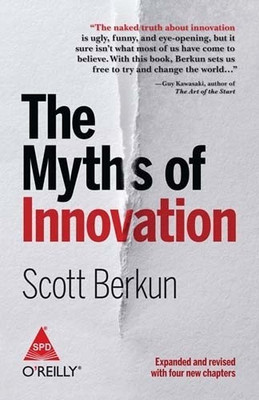The Myths of Innovation(English, Paperback, Berkun Scott)
Quick Overview
Product Price Comparison
In this new paperback edition of the classic bestseller, you'll be taken on a hilarious, fast-paced ride through the history of ideas. Author Scott Berkun will show you how to transcend the false stories that many business experts, scientists, and much of pop culture foolishly use to guide their thinking about how ideas change the world. With four new chapters on putting the ideas in the book to work, updated references and over 50 corrections and improvements, now is the time to get past the myths, and change the world. You'll have fun while you learn: Where ideas come from The true history of history Why most people don't like ideas How great managers make ideas thrive The importance of problem finding The simple plan (new for paperback) Since its initial publication, this classic bestseller has been discussed on NPR, MSNBC, CNBC, and at Yale University, MIT, Carnegie Mellon University, Microsoft, Apple, Intel, Google, Amazon.com, and other major media, corporations, and universities around the world. It has changed the way thousands of leaders and creators understand the world. Now in an updated and expanded paperback edition, it's a fantastic time to explore or rediscover this powerful view of the world of ideas. About the Author Scott Berkun was a manager at Microsoft from 1994-2003, on projects including v1-5 (not 6) of Internet Explorer. He is the author of three bestselling books, Making Things Happen, The Myths of Innovation and Confessions of a Public Speaker. He works full time as a writer and speaker, and his work has appeared in The New York Times, Forbes magazine, The Economist, The Washington Post, Wired magazine, National Public Radio and other media. He regularly contributes to Harvard Business and BusinessWeek, has taught creative thinking at the University of Washington, and has appeared as an innovation and management expert on MSNBC and on CNBC. He writes frequently on innovation and creative thinking at his surprisingly popular blog: scottberkun.com and tweets at @berkun. His ambition in life is to fill the above bookshelf, which is by his writing desk, with books he has written. If he were smarter, heŌĆÖd have picked a smaller shelf. HeŌĆÖs based in Seattle, WA, but speaks often all around the world speaking about creativity and other topics heŌĆÖs written about. If youŌĆÖd like to hire him to speak at an event, head over here: www.scottberkun.com. You can watch videos of him in action and get in touch. Table of Contents Chapter 1 The myth of epiphany ┬Ā┬Ā┬Ā Ideas never stand alone Chapter 2 We understand the history of innovation ┬Ā┬Ā┬Ā Why does history seem perfect? ┬Ā┬Ā┬Ā Evolution and innovation Chapter 3 There is a method for innovation ┬Ā┬Ā┬Ā How innovations start ┬Ā┬Ā┬Ā The seeds of innovation ┬Ā┬Ā┬Ā The challenges of innovation ┬Ā┬Ā┬Ā The infinite paths of innovation ┬Ā┬Ā┬Ā Finding paths of innovation Chapter 4 People love new ideas ┬Ā┬Ā┬Ā Managing the fears of innovation ┬Ā┬Ā┬Ā Negative things innovators hear ┬Ā┬Ā┬Ā The innovatorŌĆÖs dilemma explained ┬Ā┬Ā┬Ā Frustration + innovation = entrepreneurship? ┬Ā┬Ā┬Ā How innovations gain adoption: the truth about ideas before their time Chapter 5 The lone inventor ┬Ā┬Ā┬Ā The convenience of lone inventors ┬Ā┬Ā┬Ā The challenge of simultaneous invention ┬Ā┬Ā┬Ā The myth of the lone inventor ┬Ā┬Ā┬Ā Stepping-stones: the origins of spreadsheets and E=mc2 Chapter 6 Good ideas are hard to find ┬Ā┬Ā┬Ā The dangerous life of ideas ┬Ā┬Ā┬Ā How to find good ideas ┬Ā┬Ā┬Ā Ideas and filters Chapter 7 Your boss knows more about innovation than you ┬Ā┬Ā┬Ā The myth that managers know what to do ┬Ā┬Ā┬Ā Five challenges of managing innovation Chapter 8 The best ideas win ┬Ā┬Ā┬Ā Why people believe the best wins ┬Ā┬Ā┬Ā The secondary factors of innovation ┬Ā┬Ā┬Ā Space, metrics, and Thomas Jefferson ┬Ā┬Ā┬Ā The goodness/adoption paradox Chapter 9 Problems and solutions ┬Ā┬Ā┬Ā Problems as invitations ┬Ā┬Ā┬Ā Framing problems to help solve them ┬Ā┬Ā┬Ā The truth about serendipity Chapter 10 Innovation is always good ┬Ā┬Ā┬Ā Measuring innovation: the goodness scale ┬Ā┬Ā┬Ā Innovations are unpredictable (DDT, automobiles, and the Internet) ┬Ā┬Ā┬Ā Technology accelerates without discrimination ┬Ā┬Ā┬Ā The good and bad, the future and the past Chapter 11 Epilogue: Beyond hype and history ┬Ā┬Ā┬Ā The simple plan Chapter 12 Creative thinking hacks ┬Ā┬Ā┬Ā Kill creative romance ┬Ā┬Ā┬Ā Combinations ┬Ā┬Ā┬Ā Inhibition ┬Ā┬Ā┬Ā Environment ┬Ā┬Ā┬Ā Persistence ┬Ā┬Ā┬Ā Creative thinking hacks Chapter 13 How to pitch an idea ┬Ā┬Ā┬Ā All ideas demand change Chapter 14 How to stay motivated ┬Ā┬Ā┬Ā The big motivations Appendix Research and recommendations ┬Ā┬Ā┬Ā Annotated bibliography ┬Ā┬Ā┬Ā Ranked bibliography ┬Ā┬Ā┬Ā Other research sources Appendix Photo credits ┬Ā┬Ā┬Ā Chapter openers ┬Ā┬Ā┬Ā Figures Appendix Acknowledgments ┬Ā┬Ā┬Ā For the paperback edition ┬Ā┬Ā┬Ā For the original edition Appendix How to help this book: A request from the author Colophon ┬Ā


